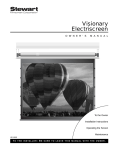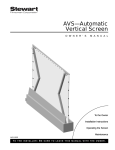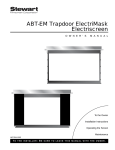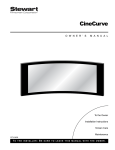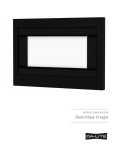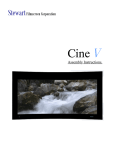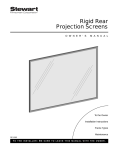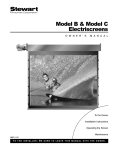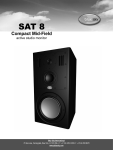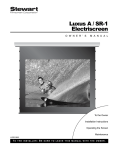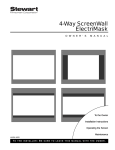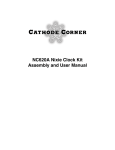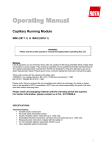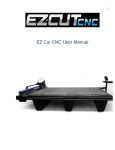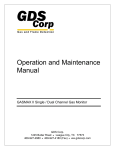Download Stewart Filmscreen - Luxus Model A Manual
Transcript
Luxus A Electriscreen Owner’s Manual • TO THE OWNER • INSTALLATION INSTRUCTIONS • OPERATING THE SCREEN • MAINTENANCE LXSR-0111 TO THE INSTALLER : BE SURE TO LEAVE THIS MANUAL WITH TH E OWNER. Printed in U.S.A. ©2003–2011 Stewart Filmscreen Corporation Stewart Filmscreen reserves the right to make changes to the product specified in this document. From time to time, this document is updated. Current versions of documentation are posted on the Stewart Filmscreen website at: www.stewartfilmscreen.com Luxus A Electriscreen Owner’s Manual Contents To the Owner . . . . . . . . . . . . . . . . . . . . . . . . . . . . . . . . . . . . . . 2 Preparing the Installation . . . . . . . . . . . . . . . . . . . . . . . . . . . . . 2 Step 1. Hanging the Case . . . . . . . . . . . . . . . . . . . . . . . . . . . . 4 Step 2. Electrical Hook-up . . . . . . . . . . . . . . . . . . . . . . . . . . . . 6 Operating the Screen . . . . . . . . . . . . . . . . . . . . . . . . . . . . . . 12 Adjusting the Screen Extension . . . . . . . . . . . . . . . . . . . . . . . 13 Screen Care and Cleaning . . . . . . . . . . . . . . . . . . . . . . . . . . 15 Troubleshooting . . . . . . . . . . . . . . . . . . . . . . . . . . . . . . . . . . . 16 Product Warranty . . . . . . . . . . . . . . . . . . . . . . . . . . . . . . . . . 17 Luxus A Electriscreen: Owner’s Manual 1 TO THE OWNER Congratulations on your purchase of the finest optical viewing screen available anywhere in the world! Please take a moment to review this manual, it will help ensure you many years of trouble-free service from your new Stewart Filmscreen product. About your Luxus A Series Electriscreen This is Stewart’s most popular electric roll up unit because it can accommodate screen sizes up to 66” x 122” / 167 x 310 cm. Typically, the screen housing is hidden above the ceiling, and the screen descends through a slot in the ceiling. PREPARING THE INSTALLATION Before proceeding with the installation of this screen, be sure to thoroughly read and understand all the installation and operating instructions. All electrical wiring installations must conform to local and national codes and should be performed by qualified service personnel. There are no user-serviceable parts contained within the unit. Preparation Specifications regarding the individual screen dimensions, weight, mounting type, and controls are provided by the factory when the unit is ordered. Before beginning the installation: Check the specifications for the type of mounting and switch control to be used. Ensure that the mounting area and electrical connection are prepared. Check the size and weight of the screen to be installed so that you can plan for the number of people required for the mounting procedure. You need at least two people to mount the smaller screens; more are needed for larger, heavier screens. On the screen housing, note the removable Image Centerline sticker. Use the sticker to help you accurately position the screen. Be sure to remove this sticker after installation. You will need: 2 Enough ladders for the personnel supporting the screen during the mounting process A level Fasteners appropriate for the surface on which the screen is being mounted Stewart Filmscreen Corporation Note: This manual refers to “AC” to represent electrical power. Your location may use 120V, 220V, or other electrical power. Screen systems are manufactured using the electrical power type specified for the location. Use appropriate power sources for your location. Caution During installation, do not place the unit on an unstable cart, stand, table, or ladder. The unit may fall, causing injury to a child or adult and damage to the unit. Unpacking 1. Remove the outer plastic covering and white wrapping paper surrounding the screen case. 2. Do not remove the wrapping paper surrounding the screen roller. You should remove it only after the unit is hung and all electrical connections have been made. 3. Remove the batten lock-down screws located on the back side of the case. Warning! Failure to remove the batten lock-down screws can result in permanent damage to the screen. To avoid damage to the screen while unpacking, lifting, or installing this electric projection screen, do not compact the screen's batten bar against the screenroll assembly. Installers should never use their hands or allow any tools or equipment to come into contact with the screen's batten or screenroll assembly. Lifting should be performed only at the ends of the housing. If manual support is required, use hands only, and only on the exterior of the housing. Projection screens should always be protected when installed in unfinished rooms. Damage will result if left unprotected in these situations. Make sure screen is retracted at all times and electrical service to the unit is shut off. Cover the ceiling opening with plastic sheeting to guard against foreign debris (such as dry wall dust or paint) from entering screen housing. Remember to remove protective plastic sheeting prior to screen's first-time activation upon room's completion. Luxus A Electriscreen: Owner’s Manual 3 STEP 1. HANGING THE CASE Professional mounting techniques should be used. Stewart Filmscreen Corporation cannot be liable for substandard or faulty installations. Make sure that you mount the screen so that the electrical box is on the left side (audience left). Wall installation 1. Mount screen through the holes in the wall mount brackets. Refer to Figure 1. – If mounting onto a wood substructure, #12 screws can be used. – If the unit is to be mounted to plaster, drywall, masonry, or othertype of surface, use an appropriate fastener. (These might include toggle or molly bolts or similar fasteners.) 2. Make sure the unit is level from side to side and front to back. Figure 1: Wall mount using optional brackets Electrical Connection Box (behind end plate) Ceiling or top mount installation The Luxus Electriscreen can be installed into the ceiling or soffit. A false ceiling is not intended to support the weight of a Luxus Electriscreen. Make sure that you mount the screen so that the electrical box is on the left side (audience left). Refer to Figure 2 Socket Cap Screws Electrical Knockout (optional) If the unit is to be mounted to plaster, drywall, masonry, or other type of surface, use an appropriate fastener. (These might include toggle or molly bolts or similar fasteners.) There are two types of ceiling or top mount: recessed or suspended. Follow the procedure for the specified type of mounting. Figure 2: Ceiling or top mount 4 Stewart Filmscreen Corporation Recessed or concealed mount Support Structure You can install the screen so that the motor is recessed and the bottom is flush with dry wall or a suspended ceiling. Refer to Figure 3. 1. Attach the supplied ceiling mount brackets to the top of the screen unit. 2. Install the unit onto the support structure making sure that the bottom of the case is flush with the finished ceiling. 3. Make sure the unit is level from side to side and front to back. Factory Advisory Drywall or Suspended Ceiling Figure 3: Recessed or concealed mount The factory advises against installing a concealed or recessed electrical projection screen permanently. You must be able to access and remove the unit should future service be necessary. Suggested solutions for removing the unit include: A removable ceiling cover plate under the mounting location Access to the unit through an attic or overhead space Suspended installation When suspended installation is desired, use the eyebolts that are provided with the screen. 1. Remove the screw farthest from the end plate. Install the eyebolt at that central pivot location. Repeat on the opposite end. 2. Suspend the unit from the eye bolts on the unit using chains, cables, or turnbuckles. Refer to Figure 4. 3. Make sure the unit is level. Figure 4: Suspended installation Luxus A Electriscreen: Owner’s Manual 5 STEP 2. ELECTRICAL HOOK-UP Caution Professional techniques need to be used when making any electrical connection. A qualified electrician should perform these procedures. Be sure to follow all standard safety procedures for installing electrical devices. Do not disassemble or alter the configuration of the motor or the unit's electrical connections. This may cause injury to you or damage to the product. Electrical Connection Box (behind end plate) The electrical connection should be made only to the type of power source indicated on the marking label. The motor requires standard AC input. All connections are made to the electrical box on the side of the Luxus unit (audience left). Socket Cap Screws Electrical Knockout (optional) In addition to the standard high-voltage 3-position switch, there are optional switch controls available for the Luxus Electriscreen. Follow the installation procedure for the type of switch control you will install. General suggestions for wiring: Soldering is recommended. The use of wire nuts is acceptable. On models not provided with armored whip, a romex connector should be installed in the appropriate electrical KO (Knock Out). To open the electrical box, remove the two socket cap screws that attach the end plate to the unit’s case. Figure 5: Electrical connection box Refer to Figure 5 for an illustration of the electrical connection box on the side of the screen unit. The standard electrical connection is through the large black electrical grommet located on the back side of the case adjacent to the end plate. An optional electrical knockout has been provided should the particular installation require that the electrical connection be made through the side end plate. 6 Stewart Filmscreen Corporation Installing the high voltage switch control (standard) A standard 3-position wall switch is supplied. The high-voltage control is connected to the electrical source. It alternates directions of screen motion by means of the hot lead, using the 3-position switch. Preparing the connection Before making the electrical connections, you need: An available AC constant power source A 4-conductor romex or motor connector cable Making the connections The diagram in Figure 6 illustrates the connections. 1. Connect the wall switch to the AC constant power source. 2. Connect the wall switch to the screen unit’s electrical box. To do this, you need to remove the end plate and connect your connector cable. Warning! Do not connect multiple high voltage control switches to one screen motor. For custom switching applications, contact the factory. DOWN-Black UP-Red Line (Hot) COMMON-White Neutral AC Power Source Screen Switch GROUND-Green Figure 6: High voltage control wiring diagram Luxus A Electriscreen: Owner’s Manual 7 Installing the screen trigger interface option The optional 12V screen trigger interface enables up and down operation of the screen in conjunction with a projector, tuner, VCR, cable box, or switched AC outlet. Once the AC power outlet is installed near the screen, an electrician is not needed to connect the screen trigger interface to the power source. Note: An optional 12V DC transformer is used if there is no 12V power source from the projector or AV control center. Preparing the connection Before making the electrical connections, you need: An available AC constant power source installed near the screen Making the connection The electrical diagram in Figure 7 illustrates the connection. 1. Plug the AC power cord into the AC outlet. 2. Attach the 12V trigger wire to the jack on the back side of the case adjacent to the power cord. 3. Use the supplied quarter-inch mono phone plugs to terminate the 12V trigger wire. To Projector or Optional 12V DC Transformer With Switch AC Power Source AC Power Source Figure 7: Screen trigger interface connection 8 Stewart Filmscreen Corporation Installing the low-voltage 3-button switch option The optional Stewart Filmscreen low-voltage control (LVC) allows the use of low-voltage wire to connect to the supplied 3-position 24V momentary wall switch. Preparing the connection Before making the electrical connections, you need: An available AC constant power source A 4-conductor switch hook-up cable (4-conductor bell wire or category 5 cable for long runs) Cat 5, multi-conductor unshielded, or similar type electronic cable can be used to connect the 3-button switch to the LVC. The recommended wire gauge is 20 to 24 AWG. Use plenum-rated cable when required. Making the connection Refer to the diagram that is located on the white label inside the steel housing, and to Figure 8. 1. Mount the low-voltage control box near the screen. 2. Connect the low-voltage control box to the screen by connecting the screen motor power leads to the power strip terminal block located on the circuit board of the control box. 3. Connect the low voltage control box to the AC power source by connecting the AC line voltage to the power strip terminal block located on the circuit board of the control box. 4. Connect the switch to the low-voltage control box. Note: A parallel connection to an outboard audio-visual switching network can be made at this time. (optional) AC Power R/F Input Line Neutral COMMON-White InfraRed Input UP-Red DOWN-Black Ground STOP-Yellow Low Voltage Switching COMMON-White UP-Red DOWN-Black Low Voltage Control Box 4 Conductor Hook-up Cable—20-24ga Recommended Category 5 Typically Used (NOT Supplied) Figure 8: Low voltage 3-button switch wiring Luxus A Electriscreen: Owner’s Manual 3-button Momentary Switch 9 Installing the infrared remote control option The optional Stewart Filmscreen infrared remote control allows control of the screens from anywhere in the room. Note: The distance between the hand-held remote control and the receiver can be up to 50 feet / 15 m. It is necessary to have uninterrupted line-ofsight between the remote and the receiver. Preparing the connection Before making the electrical connections, you need: An available AC constant power source A 4-conductor switch hook-up cable (4-conductor bell wire or category 5 cable for long runs) Cat 5, multi-conductor unshielded, or similar type electronic cable can be used to connect the 3-button switch to the LVC. The recommended wire gauge is 20 to 24 AWG. Use plenum-rated cable when required. Making the connection Refer to the diagram that is located on the white label inside the steel housing, and to Figure 9. 1. Follow the steps for installing the low-voltage 3-button switch option on the previous page. 2. Mount the infrared (IR) eye sensor near the screen. 3. Connect the IR eye sensor to the small black plug in module located next to the switch input on the circuit board. Infrared Sensor Infrared Remote Control AC Power R/F Input Line Neutral COMMON-White InfraRed Input UP-Red DOWN-Black Low Voltage Switching STOP-Yellow COMMON-White UP-Red DOWN-Black Ground Low Voltage Control Box 4 Conductor Hook-up Cable—20-24ga Recommended Category 5 Typically Used (NOT Supplied) Figure 9: Infrared remote control wiring 10 3-Button Momentary Switch Stewart Filmscreen Corporation Installing the wireless remote control option The optional Stewart Filmscreen wireless remote control allows control of the screens from anywhere in the room. Note: The distance between the hand-held remote control and the receiver can be up to 50 feet / 15 m. It is not necessary to have uninterrupted lineof-sight between the remote and the receiver, but there should be no metal objects between them. The override switch on the bottom of the receiver can be used instead of the remote control. Preparing the connection Before making the electrical connections, you need: An available AC power source installed near the screen Making the connection The electrical diagram in Figure 10 illustrates the connections. 1. Connect the 4-conductor cable to the receiver module. 2. Open the wireless remote receiver module and connect motor wires according to the labels inside. 3. Plug the receiver module into the constant AC power source. Connect to motor AC Wireless Remote Control Wireless Remote Receiver Module Figure 10: Wireless remote control connection Luxus A Electriscreen: Owner’s Manual 11 OPERATING THE SCREEN The method you use to raise and lower the screen depends on the type of switch control devices you have selected. When you lower or retract the screen, it will stop at its preset limit. If an obstacle (such as a person or furniture) gets in the path of the screen as it is lowered, you should use the switch control to stop the screen's motion; it will not automatically stop if it hits an obstacle. The motor is designed to be used for short operations such as lowering the screen in preparation for viewing. The motor is not designed for continuous duty. If the motor operates continually for more than a few minutes, it may automatically shut off to prevent damage from overheating. If the motor occasionally needs to be run more than normal, for example during initial setup and positioning, allow time for the motor to cool down. In general, when the screen is not in use, you should store it in the fully retracted position. Caution Do not operate the motor when any of the following occurs: The unit emits any smoke, heat, abnormal noise or unusual odor. The unit is damaged in some way, such as damage from a water leak. If any of these situations occur, call a qualified service person. 12 Stewart Filmscreen Corporation ADJUSTING THE SCREEN EXTENSION Caution Improper adjustment of the limit switches can cause irreparable damage to the screen itself, resulting in voiding the factory warranty. The extension and retraction limit switches have been preset at the factory. In general, we advise you to avoid readjusting these switches. In some cases, to enable proper alignment of the displayed image on the screen, you may need to adjust the extension of the screen. If adjustment to the extension is necessary, carefully follow these instructions. Warning! The screen is fully retracted when the batten is flush with the bottom of the case. Do not attempt adjustments with the yellow retraction (UP) limit switch that will further retract the screen. Incorrect adjustment of the switch will cause severe screen damage. Consult the factory if you have any questions. Modifying the extension of the screen Down Limit Switch Up Limit Switch You can increase the extension of the screen up to 3" (7.5 cm) past the factory preset stop, or you can decrease the extension by approximately 4-6" (10 - 15 cm) from the factory preset stop. Do not attempt to modify the screen extension beyond these recommended amounts. The limit switches are located on the left side of the screen roller tube inside the case, as shown in Figure 11. To increase the screen's fully extended (screen down) stop position: 1. Lower the screen to its current stop position. Screen 2. Locate the white extension (down) limit switch on the left side of the screen tube. You access the white limit switch through the small electrical grommet located on the case next to the end plate. Use a small electrician’s style screwdriver or a 5/32” (.4 cm) hex wrench to turn the switch in a counterclockwise direction. If the power is still on, the screen will drop incrementally as the switch is turned. Note: One complete turn of the switch will make approximately a 3/4" (2 cm) change in the screen's stop position. Figure 11: Underside view of Luxus Luxus A Electriscreen: Owner’s Manual 13 To decrease the screen extension: 1. Lower the screen until it is extended about halfway down. Note: If your Luxus screen has a screen trigger, leave in the up retracted position. 2. Locate the white extension (down) limit switch on the left side of the screen tube. You access the white limit switch through the small electrical grommet located on the case next to the end plate. Use a small electrician’s style screwdriver or a 5/32” (.4 cm) hex wrench to turn the switch in a clockwise direction. Note: One complete turn of the switch will make approximately a 3/4" (2 cm) change in the screen's stop position. 3. Activate the screen in the down direction until it reaches the newly reduced stop position. Repeat this procedure until the desired stop position is reached. Once you have made the adjustment, whenever you lower the screen, it will automatically stop at the new position. Note: It is recommended that you make a note of any changes made to the factory preset. 14 Stewart Filmscreen Corporation SCREEN CARE AND CLEANING With reasonable care, you may expect many years of trouble-free use of your Stewart projection screen. We encourage you to keep your screen clean. To protect your screen when it is not in use, store it in the fully retracted position. Avoid getting any foreign material on the screen, as cleaning may prove very difficult. It may not be possible to remove scratches, paint, ink, etc. General maintenance The screen surface on your screen is delicate. Special attention to these instructions should be followed when cleaning. A draftsman-style brush may be used to lightly whisk away any loose dirt or dust particles. (This type of brush is usually available at office supply stores.) Stewart Filmscreen has an optional screen cleaning kit that contains the proper type of brush. Contact your dealer if you would like to obtain this cleaning kit. Particles left on the screen when it is retracted into the case may form an impression on the screen surface. Periodically wipe the back of the screen with a clean damp cloth. For tougher spots, use a solution of mild detergent and water. Rub lightly using a sponge. Blot with a damp sponge to absorb excess water. Residual water marks will evaporate within a few minutes. Let the screen air dry completely before retracting. Do not use any other cleaning materials on the screen. Contact the factory if you have questions about removing difficult spots. Replacement parts and service No user-serviceable parts are contained within the unit. Contact your dealer or the factory if you require part replacement or service. Luxus A Electriscreen: Owner’s Manual 15 TROUBLESHOOTING Refer to the following guidelines if you encounter a difficulty in the operation of your Stewart Filmscreen. Problems related to electrical or motor function may require a qualified service person or electrician. Should you have a problem that is not addressed here, call the Stewart Filmscreen Corporation. Problem description Screen won't operate. Probable cause No AC power available Outboard switching problem Action to take Check to see if the circuit breaker has switched off. Reset if needed. Check voltage availability. Contact an electrician. Screen won't roll up or down (even though power is available). Bad connection at switch Have an electrician or qualified service person check the connection as follows: Screen roller chatters when power is activated. Can be caused by voltage drop, bad connections, or a defective switch. Have an electrician or qualified service person check all hook-ups including all outboard wiring. Unit hums in up mode. (Screen has already retracted.) The screen batten is retracting too far into the case. Failure to correct can damage motor and screen. Do not use the unit until this problem is resolved. Have a qualified service person adjust the yellow UP limit switch. Turn the adjusting screw clockwise. Screen drops when up direction is activated (grinding noise occurs). Drop in voltage Screen motor requires full voltage. Have an electrician or qualified service person check available voltage. Screen continues past bottom stop position. White limit switch is out of adjustment. Readjust the white DOWN limit switch. Turn the adjusting screw clockwise. Batten retracts too far into case. Yellow limit switch out of adjustment. Failure to correct can damage motor and screen. Do not use the unit until this problem is resolved. Have a qualified service person readjust the yellow UP limit switch. Turn the adjusting screw clockwise. Motor shuts off. Motor has been in use for more than 2 minutes. Motor is designed for short operations (lowering and retracting), not continuous duty. Longer operation, such as during setup and positioning, causes the motor to overheat and shut off. Allow the motor to cool down. Complete cooling can take an hour or more. Heat gain is cumulative and takes time to dissipate. If motor use is initiated before it has cooled completely, the motor will shut down again when it reaches maximum temperature. Dirt, finger prints, marks, etc. are on screen surface. Improper handling of screen Brush off or use a mild detergent solution with clean rag or cotton swab. Indentations appear on screen surface. Debris or particles adhering to screen due to static cling Check back of screen; gently brush debris away by hand. N If you have a high voltage control switch, check switch-line connections. N If you have a low voltage control unit, check switch-line connections. N If you have a screen trigger interface, contacts may be sticking—tap relay to free contacts. Any controller (e.g., STI, LVC, etc.) fails to operate motor. 16 Stewart Filmscreen Corporation PRODUCT WARRANTY LIMITED ONE (1) YEAR WARRANTY ON STEWART FILMSCREEN CORP PROJECTION SCREENS SYSTEM STEWART FILMSCREEN CORPORATION (Stewart) warrants its screens to the original purchaser only, to be free from defects in materials and workmanship for a period of one (1) year from the date of purchase by the original purchaser or eighteen (18) months from date of manufacture, as defined in the serial number, provided they are properly operated and maintained according to Stewart instructions and are not damaged due to improper handling or treatment after shipment from the factory. This warranty does not apply to equipment showing evidence of misuse, abuse, or accidental damage, including neglect caused by improper installation (i.e. proximity to hot lights, exposure to extreme heat or cold, exposure to excessive humidity, etc.) as well as product that have been tampered with or repaired by any person or third party installation, other than authorized Stewart personnel. Stewart's sole obligation under this warranty shall be to repair or to replace (at Stewart's sole discretion) the defective part of the merchandise. This warranty expressly does not cover any costs of removal, installation, framing, or other costs incident to replacing the screen or returning it to Stewart. Returns for service should be made to your Stewart dealer. If it is necessary for the dealer to return the screen or part to Stewart, transportation (freight) expenses to and from Stewart are payable by the purchaser and Stewart is not responsible for damage in shipment. To protect yourself against damage or loss in transit, insure the product and prepay all transportation expenses. This warranty is in lieu of all other warranties, expressed or implied, including warranties as to fitness for use and merchantability. Any implied warranties of fitness for use, or merchantability, that may be mandated by statue or rule of law are limited to the one (1) year warranty period. This warranty gives you specific legal rights, and you may also have other rights which vary from state-to-state. In no event will Stewart be liable for sums in excess of the purchase price of the product. No liability is assumed by Stewart for expenses or damages resulting from interruption in operation of equipment, or for incidental, direct, or consequential damages of any nature. In the event that there is a defect in materials or workmanship of a Stewart Screen, you may contact our Customer Service Department at 1161 W Sepulveda Blvd, Torrance, California 90502-2797 (310-784-5300) Toll free (800-762-4999). IMPORTANT: This warranty shall not be valid and Stewart shall not be bound by this warranty if the product is not operated and maintained in accordance with Stewart's written instructions. Stewart Filmscreen Corporation shall not be liable for any and all consequential damage(s) occasioned by the breach of any written or implied warranty pertaining to the sale in excess of the purchase price of the product sold. Printed in USA. Rev. 12/14/10 Luxus A Electriscreen: Owner’s Manual 17 800.762.4999 • 310.784.5300 • Fax: 310.326.6870 www.stewartfilmscreen.com January 2011 Printed in U.S.A. ©2003–2011 Stewart Filmscreen Corporation




















